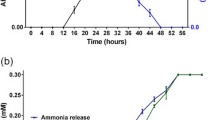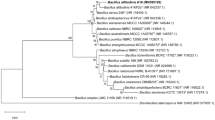Abstract.
The isolated soil bacteria Acinetobacter strain BEM2 is able to utilize some xenobiotic aromatic compounds as a carbon source. In this study the metabolism of 4-hydroxybenzoate (4-HBA) by strain BEM2 was characterized. Degradation involved a meta-cleavage pathway yielding 3,4-dihydroxybenzoate (3,4-DHBA) as an intermediate and CO2 as the principal product from the C atoms in the aromatic ring. 4-HBA uptake was studied, and the kinetic parameters were determined. The uptake was shown to be directly coupled to ATP hydrolysis and its synthesis, according to the Mitchell chemiosmotic hypothesis.
Similar content being viewed by others
Author information
Authors and Affiliations
Additional information
Received: 29 June 1999 / Accepted: 2 August 1999
Rights and permissions
About this article
Cite this article
Allende, J., Gibello, A., Fortún, A. et al. 4-Hydroxybenzoate Uptake in an Isolated Soil Acinetobacter sp.. Curr Microbiol 40, 34–39 (2000). https://doi.org/10.1007/s002849910007
Issue Date:
DOI: https://doi.org/10.1007/s002849910007




